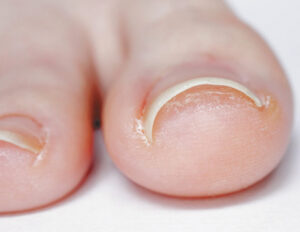By Dr. Isin Mustafa, DPM, MSHS, FACFAS, DABPM
 An ingrown toenail is defined by a nail growing into the skin. Typically, the sides of the nail begin to curve or grown into the skin at one or both sides of the nail border. Mostly commonly seen in the big toe, but it can occur in other toes as well. Once the nail begins to dig into the skin pain, swelling and redness will soon follow. These are early symptoms of an ingrown that should be aware of. Other symptoms include worsening pain when in closed toed shoes. Overtime, the nail can pierce the skin creating an open wound and possible infection if not treated. Signs of infection are worsening pain, redness, swelling and foul smelling drainage or pus.
An ingrown toenail is defined by a nail growing into the skin. Typically, the sides of the nail begin to curve or grown into the skin at one or both sides of the nail border. Mostly commonly seen in the big toe, but it can occur in other toes as well. Once the nail begins to dig into the skin pain, swelling and redness will soon follow. These are early symptoms of an ingrown that should be aware of. Other symptoms include worsening pain when in closed toed shoes. Overtime, the nail can pierce the skin creating an open wound and possible infection if not treated. Signs of infection are worsening pain, redness, swelling and foul smelling drainage or pus.
Ingrown toe nails can be genetic meaning it runs in your family (hereditary). Trauma can also be a cause. An example of trauma includes stubbing your toe, having something fall on it, and activities that cause repeated pressure on the toes like kicking or running. One of the most common causes is improper trimming of the toe nails. You don’t want to cut your nails too short as this allows the skin next to the nail to fold over the nail. Another common cause is improper shoe size or socks that are too small/tight. Furthermore, nail fungus can also contribute to the development of ingrown nails
If you develop pain at the sides of the nail with redness, swelling and drainage you should seek treatment. The ingrown nail can progress into an infection if the ingrown nail is not removed. If you have diabetes, nerve damage or poor circulation you should not attempt to self-treat and seek professional treatment right away.
If you are not high risk or do not have an infection you can try to soak the foot in room-temp water with Epsom salt. Do not attempt to cut the nail yourself as repeated cutting of the nail can cause it become worse over time. If you pain continues, than seek treatment by a foot and ankle specialist.
Your physicians will exam your toe and determine the best treatment based on the severity of your condition. If an infection is present you will require oral antibiotics. A minor procedure if often required for treatment of an ingrown nail. The procedure is performed in the office. First local anesthetic will be used, followed by cleaning the toe and removal of the portion of the nail that has become ingrown. In order to prevent recurrence a chemical may be used to kill the root of the nail so the ingrown portion of the nail does not return. The entire nail is not removed but only the corner that has become ingrown. A bandage will then be applied that will remain in place for 24 hours. You may experience mild soreness on the 2nd or 3rd day but you are able to walk right away.
Some methods for prevention include proper trimming. Cut your nails straight across and do not cut them too short. Make sure to wear properly fitting shoes and socks. Do not use shoes that are too big/loose as this can cause pressure to the toe when engaging in physical activity as well. Avoid trying to trim the nail border or having a pedicurist trim the border as this can make the condition worse and does not change how the nail grown. Over the counter treatments do not typically work as they do not address the underlying cause. If you have sings of ingrown nail, contact your local foot and ankle specialist who can treat the underlying issue.
Isin Mustafa, DPM, is a Podiatrist at Family Foot & Leg Centers in Sarasota, FL. She is a Fellow of the American College of Foot & Ankle Surgeons.
Call 239-430-3668 or visit www.NaplesPodiatrist.com to make an appointment. Visit FootHealthFacts.org to learn more about foot and ankle conditions.
3110 Fruitville Commons Blvd,
Suite 102
Sarasota, FL 34240
(Next to Cooper’s Hawk restaurant)
(239) 430 – 3668 (FOOT)
www.NaplesPodiatrist.com
Disclaimer: This content is not intended to be a substitute for professional medical advice, diagnosis, or treatment. Always seek the advice of your physician or other qualified health care provider with any questions you may have regarding a medical condition.







